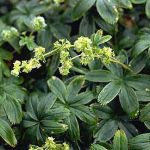| Common Name: |
Alpine Lady's Mantle |
| Botanical Name: |
Alchemilla alpina |
| Genus: |
Alchemilla |
| Family: |
Rosaceae |
| Cultivation: |
Moist, well-drained soil in sun or semi-shade. Alchemilla xanthochlora dislikes lime. |
| Propagation: |
By seed sown in early spring; by division in autumn or spring. Most alchemillas hybridize and self-seed readily. |
| Harvest: |
Whole plants (A. xanthochlora) are cur as the flowers begin to open. Leaves (A.alpina) are cut after flowering, when the foliage is quite dry. All parts are dried for infusions and liquid extracts. |
| Native Location: |
NW and C Europe and Greenland |
| Height: |
10-20cm (4-8in) |
| Width: |
10-20cm (4-8in) |
| Hardiness: |
Z3-7 |
| Parts Used: |
Leaves |
| Properties: |
An astringent, anti-inflammatory herb that controls bleeding and discharges. |
| Medicinal Uses: |
Internally for menstrual, menopausal, and postpartum problems, and for diarrhea. Externally as a mouthwash after tooth extraction, douche for vaginal discharge, or skin lotion for sores and minor injuries. It is also used in veterinary medicine to treat diarrhea. |
| Bibliography: |
Encyclopedia of Herbs by Deni Brown. Copyright © 1995, 2001 Dorling Kindersley Limited. pg 110
|

